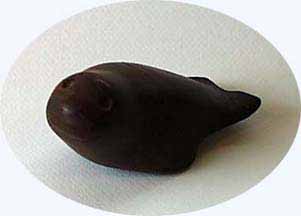
Sagadahoc Story #59: (9/28/98)
Kidstuff
All play and no work makes Jack a dumb jerk. But if your work becomes play, HeyHey. That's one reason I clung to the tag "toymaker" for so long. If it's all toymaking, how can it not be fun?
ART is serious, though. At least you hope the buyer thinks so. Artists aren't supposed to be having too much fun, or who would pay for such frivolity? The trick, then, is to be sneaky. Have fun at your work, but make lots of groaning noises. Cover your glee with angst, and high falute.
The creative people I know seem to ooze angst when they aren't working. I sure get miserable when I'm not up to some prank with materials. But even a secret glee can get bogged in self-analysis. I'd forgotten how much fun it can be to just get into the sandbox. This week I got down on all fours.
My sister Peggy had her baby (Sophia Pamela) on Monday, and I went looking in the wood bins for a baby toy. Something to grab, and throw down, and roll over, and chew on. When Seth was born I carved a seal out of lignum vitae. Apt image for a Newfoundlander, out of a boatbuilder's wood. Tapered toward the fins for a small hand to grip. Big enough at the head end to not be swallowed, but rub nicely on the gums. It proved indestructible, and saw us all through teething and the rare tantrum. I remember watching it bounce wildly across an airport terminal floor, having been flung down by a tired traveler.

But what for my new niece? Sophia is Wisdom, of course, and the name of the Goddess as I approach her. One haunting image of revelation is Ishmael's description of looking in the deep, and seeing a rising speck of white, which is Moby Dick. So small at first sight, but soon an awful shining in the darkness. Such thoughts were surfacing as I rummaged the inventory. Shimmering osage orange for a golden fish? Dense oily lignum for some submarine beast? Or this bright white ash for a whale? A small handful of wisdom, perhaps.
The key to carving flukes which won't snap off is to orient the grain with the finest sections, the tip ends and the base of the tail, and to slam the piece against the floor repeatedly, as you carve. Better you break it sooner than later. All the ash did was bounce.
My early carvings had a primitive simplicity. The result of shaping wood with a disc sander, and an untrained eye. As my hands got more sure, and my vision more sophisticated, I lost the knack of crude essentialism. Fish began to look like fish, and stopped being childish figures with fins. I've always regretted the loss of perceptual innocence. But you can't go back. Some of the alchemical carvings I did later had the symbolic power of the early fish, and sometimes a happy combination of materials and imagery happily swamped the carver's too informed perception. But any time I tried to do a "simple" carving, it came out wrong. I seemed only able to abstract by default.
Arise a small whale. The piece of wood was all wrong for an accurate image. Too fat and blunt. The way the grain turned in it didn't suit either a sperm whale or a mysticete. As the piece turned in my hands against the disc it demanded a simple shape, insisted on having no lateral fins, curved into a necessary abstraction. Tail flukes, a mouth, and eyes. After all the years I'd come full circle. Basic whale. A new beginning for an infant child. Her first gift, to me.
But this fish is very different from the early toys, too. They were for playing with. Fascinating to the touch, but ready to jump out into a make-believe. This whale settles into your hand, and wants to stay. It isn't for looking at. It's for meditating with. An inner toy. Is it possible that my carving has taken the same turn as my figure drawings? That I can finally let go of the outer shape of things, after struggling so hard to get it right? Find the innocent eye again? Do I simply need to hold an infant in mind? O boy. O girl.
A beautiful young lady, I might add. With long expressive fingers, constantly gesturing, and a calm presence, so far. My earliest memory is of looking down into a crib into the eyes of an infant, and not knowing which was who. Holding a sleeping Sophia Pamela in my arms carried me into that between place again. I suspect I'm a gonner for this babe.
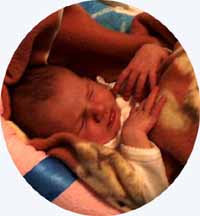
Back in the shop the childsplay continued. The last time Alison delivered chicken to us she admired the rooster on our back step, and we talked about trading chickens. I no sooner had started making a barter bird than it got out of hand. Just as my earlier barnboard marquetries were more like sketches for what I saw in my head, and then the big murals I've done this year finally approach the vision, so the cock on our step was like a 2D sketch of what I really had in mind. But the full bird is twice the size and four times the mass. We're talking a serious armload of fowl. I realized it was probably too grand for a trade good. I'd have to ask for too many broilers in return. So I laid it aside.
I've been tripping over it all summer, and finally decided to finish the critter, if only to get it out from under foot. Liberated from having to limit it's extravagance, or it's absurdity, I could sing out "... you can't roost too high for me...," and chase the image round the shop.
Here again I was walking along the edge of crude and simplistic, and reaching for a childlike vision. Seth might have been three the day he brought home a rock from Annie's gravel pit that looked like a big egg. He built an elaborate nest out of straw and left it out for the night. After he was asleep, I snuck into the shop and made a rough chicken out of weathered pine, boldly feathered but totally unfinished. I put it in the nest and hid the egg. In the morning Seth was flabbergasted, or at least willing to play the game with me. "Did that REALLY hatch out?" He asked.
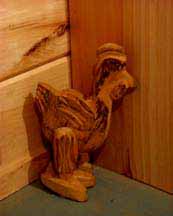
That half-baked bird has teased me ever since, and now pecks in a corner of The Seven Eagles. Only recently have I been willing to leave another carving rough and unfinished like that. The big marquetries, in fact, depend on the raw mill marks to create their syncopated cross textures. But I've balked at using roughsawn lumber for anything you could lug. This fat hen has broken the spell.
Laminated up out of rough 2by and 1by, feather-carved only on the lateral surfaces, with shaped toes and wattles and comb, the bulk of this bird is still obviously structural planking. Three foot high, her head and neck pivot from upright to pecking, and her tail cocks up and down. The galvanized screws holding her together are visible among the feathering and through the toes. Her legs are mortised into an unplaned length of 2X10, and she weights maybe 30 pounds. The wings, wattles, and comb are bright red Spanish Cedar (until it grays off), and her eyes are brass phillips heads. Give her a year out in the weather, and she'll be perfect.
Every time I thought she needed a sophisticated touch, I backed off. I thought to make her mechanically driven, and chose to let her simply be movable. I ached to round over her plank ends and feather her all around, but I resisted. I left her screw holes unplugged. She's a painful balance between sophisticated expertise and a cob job. I'm delighted with her. I think I'm finally moving into the big rough laminations I've imagined for years. Where's that hatchet?
I wouldn't have thought that moving forward to a new level of design would mean letting go of hard-earned perceptions and practiced skills. But maybe clarity of vision means closing your eyes a little. Being a dub. Playing fast and loose in the shop this week was very much like having fun. Don't tell the critics.
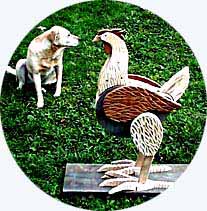 |
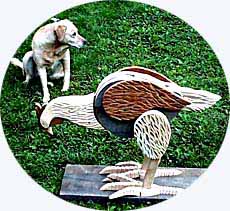 |
|
| Next Dispatch | Previous Dispatch | Dispatch Index | Home Index |